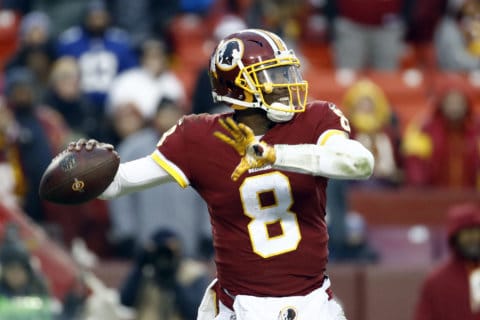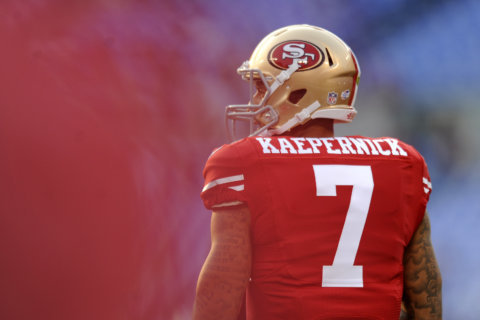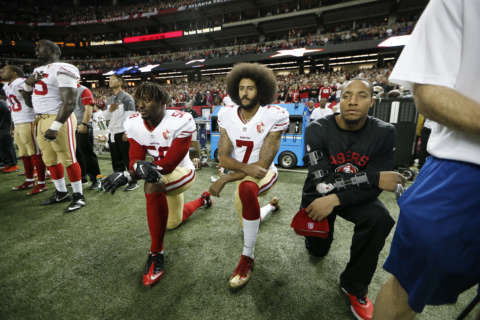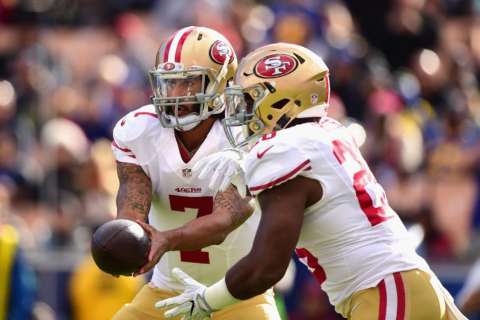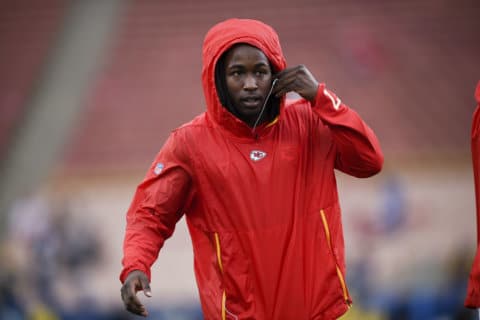WASHINGTON — Whether or not you’re a football fan, it’s impossible to deny the sport’s outsized place in American society. But football isn’t simply our biggest or most-watched sport. At its highest level, the NFL, it is a mirror of the trends of our larger society — of an increasingly diverse set of workers, but a wealthy, white ownership class, and of suppression of any kind of dissent that threatens to upend that long-held social order.
In short, the NFL is America.
The NFL is not nearly as broadly diverse as America – it’s a black (about 70 percent) and white (about 25 percent) league. But the diversity across the rosters is miles ahead of that in among those who wield power in the league, both on and off the field.
The power structure on the field is clearly defined, with quarterbacks unquestionably atop the pecking order. They call the plays; they decide where the ball goes; they make more money; they get more endorsements; they win the awards.
Since Tom Brady won his first of four Super Bowl MVPs in 2002, that honor has gone to a quarterback in 11 of the last 17 games. But that’s just one game. What about the body of work over a whole season? Since the Pro Football Writers of America started giving their MVP Award in 1975, they’ve given it to a quarterback 27 times. Twenty-five of those awards have gone to white quarterbacks, with Cam Newton (2015) and Randall Cunningham (1990) the only exceptions.
As these positions are elevated in importance, so are the rules designed to protect them. If the existing rules aren’t protective enough, they’re amplified. The fortified roughing the passer rules this year have left defensive players intentionally letting quarterbacks out of sure tackles and even injuring themselves to avoid drawing the ire of the officials. New rule changes have benefited quarterbacks even more, making the most mediocre of signal-callers into stars. The rich and powerful only get more so, at the cost of everyone else on the field.
They don’t care about the rest of us getting hurt. Long as the QB is safe https://t.co/ihjlz3lVQl
— Richard Sherman (@RSherman_25) September 24, 2018
Interestingly, even kickers and punters, regarded as largely dispensable, are protected more safely than anyone on the field. They are also overwhelmingly — 97.8 percent — white. Holders on field goals are nearly always punters or backup quarterbacks. Centers, long snappers, pretty much everyone who actually controls the ball prior to its final destination, is generally white.
There is a generic “unnecessary roughness” penalty in the game, but only specifically “roughing the passer” or “roughing the kicker/punter” infractions.
Oh, right – the long snapper is another player you can’t touch above the shoulders. Did you even know that rule?
Chris Hooks wrote in 2016 that politics is “the way we distribute pain.” The NFL pecking order is certainly that. The NFL’s on-field politics protect its marquee players — and positionally, with significant overlap, its white ones — from actual, physical pain and injury far more than its other players.
***
The players, of course, are only the bottom rung of the power ladder. Next are the coaches, 75 percent white, who make the decisions. As anyone who has played football will tell you, all deference must be paid to the coaching scheme, or system. The system is designed by (mostly) white men, and rewards (mostly) white men. It plays to the skill sets of the (mostly) white men quarterbacking teams, and has been passed down through generations of (mostly) white men, structurally reinforcing what we think of as “normal” or “traditional” or even “good” offense.
The demographic only gets whiter as you move into management, where a full 100 percent of team presidents and CEOs are white.
NFL ownership is almost exclusively old, white and male. Of the 31 teams other than the publicly-owned Green Bay Packers, all but one ownership family is white, and only a handful of primary owners are women. According to Forbes’ calculations of the various owners’ and their families’ net worth, they’re worth a combined $135.6 billion.
Much of that value, of course, is tied to the value of those 31 franchises themselves ($77.5 billion, not including the Packers, again according to Forbes), which has skyrocketed dramatically over the years. They’ve grown at an 11.6 percent average annual rate over the last 21 years since the magazine has been doing these valuations, far outpacing not just general wage growth and prosperity in America, but lapping the S&P 500 (4.5 percent).
According to Statista, the average franchise value has grown 508 percent since 2000, from $423 million to $2.57 billion. Over the same time, the average American income for each of the bottom four quintiles has stayed flat.
In 2007, the top 1 percent owned 34.6 percent of America’s wealth. By 2010, that figure was up to 37.1 percent. Now, it’s more than 40 percent.
Essentially, much of the wealth of these uber rich owners has been achieved simply through the means of having already been wealthy enough to own a team in the first place. And a significant part of the value in each franchise comes from the stadium and facilities that house them, which are nearly always paid for in large part or in full not by the ownership group, but by the public.
That trend isn’t dead yet — Las Vegas is spending $750 million in taxpayer money for the Raiders. But, thankfully, cities and states are starting to wise up to the raw deals they’ve been getting. While the price tag for the new Los Angeles football complex rises to a staggering $5 billion, taxpayers won’t be on the hook for any of it. On that count, perhaps America and the NFL are beginning to discover more egalitarian ways of doing business that stop giving free handouts to those who don’t need them at the expense of those who can’t afford them. On other counts, not so much.
***
Colin Kaepernick’s continued exile from the league remains such a captivating story because of how intertwined it is with the larger culture in 2018, because it drew in the president, because it divided fans along already-drawn battle lines created by the larger political volatility of the moment.
But also because it exposed the NFL’s oldest line about itself, that old quotation from Vince Lombardi — “Winning isn’t everything. It’s the only thing.” — for what it really meant.
Teams refused to sign Kaepernick — Houston, Buffalo, Baltimore, Jacksonville, Washington — even if he would have helped them win more games. This seems to fly in the face of Lombardi’s declaration. How, in a league in which we’re told winning is the end-all-be-all, can teams knowingly embrace losing? How can it be in this country, in which we’re told that with hard work, anybody can lift themselves up and become a success story?
The answer, in the NFL and America, is that for those in charge, true victories do not come through the wins and losses of any given day, but rather the perpetuation and fortification of the existing power structures.
Signing Colin Kaepernick this time means having no excuse not to sign the next Colin Kaepernick, the next person willing to stand up and say unpopular things, to challenge those power structures. Not signing him — supposedly for “football” reasons, even as those reasons strain even the most forgiving bounds of credulity — delays that change. It continues to signal to others that they better not ask for more than what they’ve been given, that they’re spoiled to think they deserve any more than what everyone before them has received. It’s contrary to the values we love to espouse when we speak of the idealized America in our imaginations, but is very much intertwined with the actual history of America.
As we saw in America this year, despite the supposed sea of change brought in by the #MeToo movement, when Christine Blasey Ford brought forth her own story about a man nominated for the honor of being appointed to the highest bench in our country, what happened? Was she rewarded for her courage, for standing up against the power of the Senate and the Executive Branch for what she thought was right? No. She was forced to move several times, inundated with death threats and given a pomp-and-circumstance-laden but substance-free, weeklong delay on the inevitable confirmation of her alleged abuser.
Because to allow a single challenge to such authority to succeed is to accept every challenge as credible — to actually embrace a conversation about police brutality instead of paying it lip service; to actually believe a woman with nothing to gain and much to lose when she brings forth a sexual assault claim — rather than doing the very least to escape constituent outrage. Because it’s not simply enough to ignore or refute the voices of those who challenge authority — they must be punished, as an example to others who might dare to follow.
NFL fans made their own threats, to boycott in numbers that never actually materialized, but the message was clear: This is our league. You will conform to its structures, as defined by us. We will not accommodate you.
That Kaepernick played quarterback, that all-important position, is inseparable from his exile. Eric Reed eventually got another job. Malcolm Jenkins never lost his. But they’re not the on-field leaders in the way that Kaepernick was, by merit of his position.
Even as football dominates America’s consciousness and reflects her self-perception, so does its decline. The league, like our country, has an over-inflated view of itself, and loves to trumpet its accomplishments while downplaying its shortcomings. It still fancies itself the top dog among major American sports (and, really, sports worldwide, with seemingly no understanding of European soccer’s global prominence), despite the far more technologically — and, yes, politically — progressive NBA growing in leaps and bounds while football stagnates. Even now, in the top three markets in the country, it takes a backseat to basketball, and even baseball.
Serious concerns about the future of the sport loom, with insufficient measures taken to address the brain injury crisis that affects every level of the game. What the game will look like, from how many people will participate to how many people will support it, appears ever more uncertain for the next generation.
Young men, increasingly of color, will continue to risk their health — and sometimes, quite literally their lives — for a chance to take part in it. And old, rich, (mostly) white men will continue to profit from that pain and that effort, just by the grace of being born into those positions of power.
It’s not the story we like to tell ourselves about football or America, but it’s one we can’t escape in 2018.

